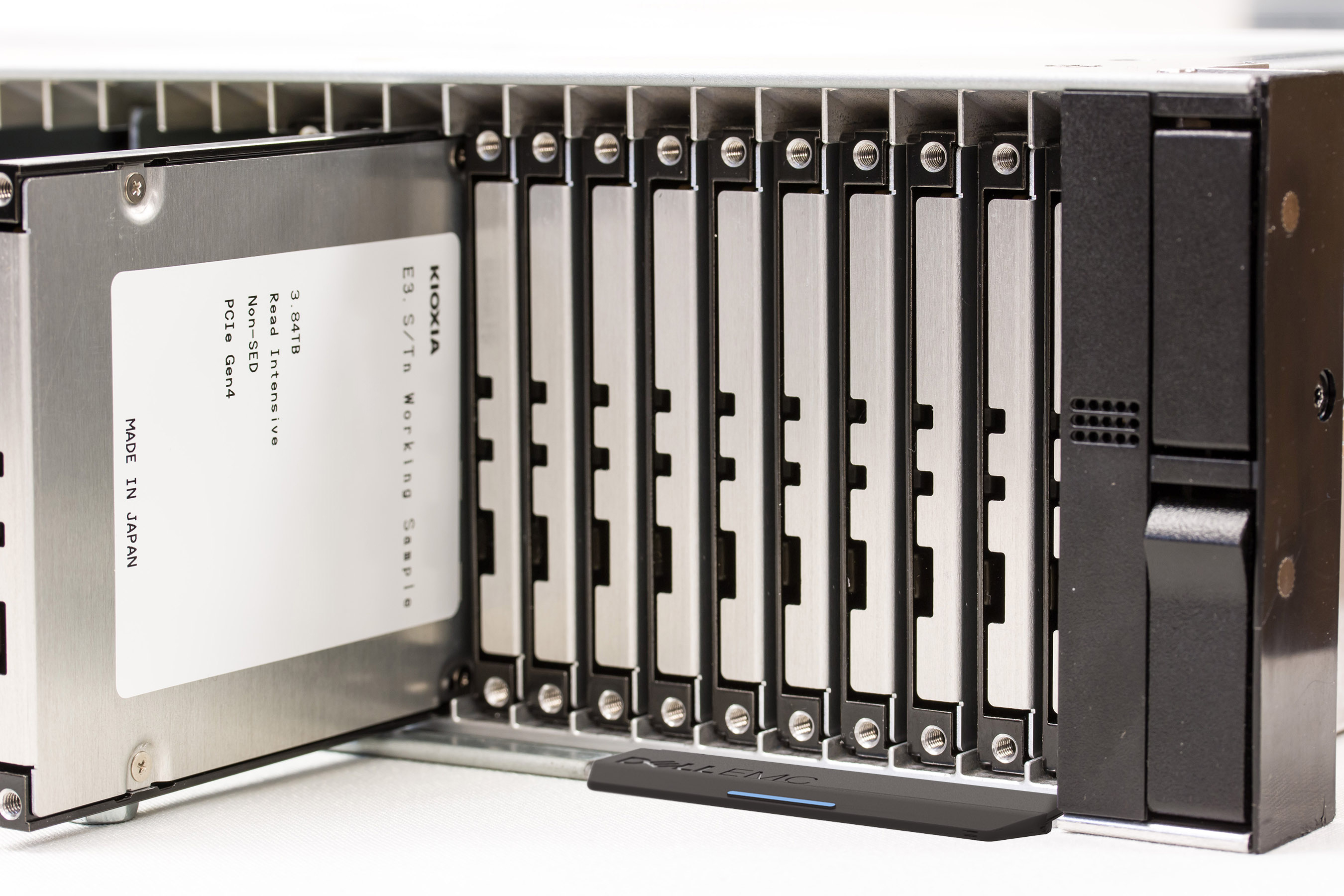Kioxia's Developing PCIe 5.0-Ready SSDs With New E3.S Form Factor
Kioxia America, previously Toshiba Memory America, has taken the wraps off new SSDs that target the enterprise and datacenter SSD form factor (EDSFF) market. Kioxia's demo announced today plays with brand new form factors under the EDSFF umbrella that seek to maximize the density and efficiency inside a system while enabling a simpler installation process.
Kioxia firmly believes that the EDSFF E3.Short (E3.S) and E3.Long (E3.L) form factors are the future of storage for servers and all-flash arrays, whether they be in a cloud or data center environment.
The EDSFF E3.S and E3.L form factors enable a higher power budget in comparison to the conventional 2.5-inch form factor. The aforementioned formats support up to 40W and are ready to exploit the level of performance that the forthcoming PCIe 5.0 interface will bring to the table. Additionally, the drives come with a better thermal dissipation outfit to tackle the heat.
Today, Kioxia announced development of E3.S SSDs that connect to the host system through a standard connector PCIe interface, just like common NVMe SSDs, graphics cards or network interface cards.
Adhering to the E3.S thin standard, the drives measure 104.9mm long and 76mm wide with a 7.5mm thickness. Kioxia hasn't branded the SSDs and didn't offer any performance numbers. The label suggests they have a capacity of 3.84TB.
"Additional E3 size and width options will also be supported, including E3.S thick (16.8mm) and E3.L thin," Kioxia said in its announcement.
According to the manufacturer, the unnamed E3.S SSDs could leverage up to eight PCIe 4.0 lanes with a power target of 28W. The E3.S drives utilize the same core components as Kioxia's recent CM6 PCIe 4.0 SSDs that landed in February. With that in mind, the E3.S units should be have a Kioxia 18-channel controller that's escorted by the brand's own 96-layer 3D TLC NAND chips.
Get Tom's Hardware's best news and in-depth reviews, straight to your inbox.
The CM6 series deliver sequential read and write speeds up to 6,200 MBps and 4,000 MBps, respectively. Random performance tops out at 1.4 million IOPS reads and 350,000 IOPs writes. However, CM6 drives are limited to four PCIe 4.0 lanes, and the E3.S drives can be configured for up to eight. It's reasonable to expect they'll deliver around better performance if their composition allows it.

Zhiye Liu is a news editor, memory reviewer, and SSD tester at Tom’s Hardware. Although he loves everything that’s hardware, he has a soft spot for CPUs, GPUs, and RAM.
-
Kamen Rider Blade WTF Kioxia?Reply
Normal 2.5" HDD/SSD that follow specs:
- 2.5" = LxWxH (mm) = 100.00 x 69.85 x (5, 7, 9.5, 12.5, 15, 19)
Your specs:
LxWxH (mm) = 104.9 x 76 x 7.5mm
Why on earth did you feel the need to break standard 2.5" drive specs? -
USAFRet Reply
"The EDSFF E3.S and E3.L form factors enable a higher power budget in comparison to the conventional 2.5-inch form factor. "Kamen Rider Blade said:Why on earth did you feel the need to break standard 2.5" drive specs? -
InvalidError Reply
This is for servers where drives plug directly into a backplane for convenient hot-swaps. There is no point in maintaining mechanical compatibility with 2.5" HDDs/SSDs when the PCIe x4/x8 backplane connector will be completely different from SATA/SAS, all it does is possibly introduce confusion when a drive that looks like it should physically fit doesn't.Kamen Rider Blade said:Why on earth did you feel the need to break standard 2.5" drive specs? -
hannibal These would be nice Also in consumer computers. Get rid of normal harddrives and sata connector and get something like these instead!Reply
But yeah... I could nor afford these :)
$10000+? -
USAFRet Reply
We already have M.2 drives. No cables.hannibal said:These would be nice Also in consumer computers. Get rid of normal harddrives and sata connector and get something like these instead!
But yeah... I could nor afford these :)
$10000+?
Not everything that exists is meant for every market or use. -
hannibal I have m2 pci 4.0 in my rig, so I,know and there is two Empty slots in there. But there is Also room for 16 3.5” hard drives and I would prefer filling those with big ssd drives ;)Reply
And sata is just too slow, so new connector for these big next gen pci 5.0 ssd would be more than fitting! -
2Be_or_Not2Be Kioxia marketing at work - so far, nothing they demonstrated is going to exceed PCIe 4.0 x 8. To claim they are going to "deliver PCIe 5.0 performance and beyond" is greatly forward-looking on their part. :rolleyes:Reply -
InvalidError Reply
If someone really wanted to toss one of these in a PC or (E)ATX server, I'm sure someone will make a PCIe slot adapter for it just like M.2 adapters were made to toss 1-4 of those on motherboards without M.2 slots.USAFRet said:Not everything that exists is meant for every market or use. -
USAFRet Reply
Yep.InvalidError said:If someone really wanted to toss one of these in a PC or (E)ATX server, I'm sure someone will make a PCIe slot adapter for it just like M.2 adapters were made to toss 1-4 of those on motherboards without M.2 slots.
And then someone here will inquire how to do a RAID 0 with 3 of them, to go into their Z68/i7-2600 system...🔫 -
bit_user Reply
I would argue that M.2 is not really meant for desktop use. They burn too much mobo realestate and are annoying to cool. Physical accessibility can also be an issue, sometimes requiring removal of the graphics card or even the whole motherboard!USAFRet said:We already have M.2 drives. No cables.
Not everything that exists is meant for every market or use.
I think the standard was just focused on laptops and maybe servers.
